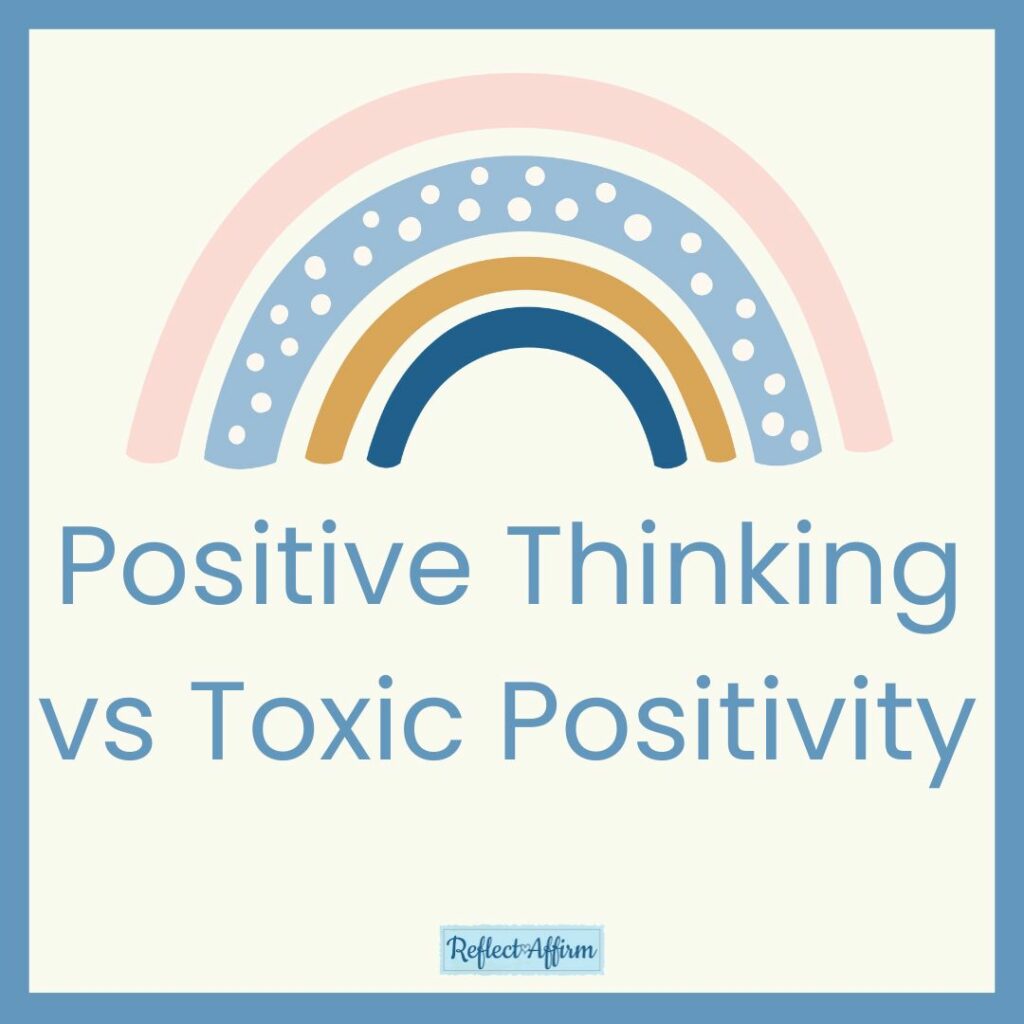
Ever felt pressured to smile through your pain? You’re not alone. We all want to feel good, but sometimes life throws us curveballs. That’s when well-meaning friends may say things like, “Look on the bright side!” or “It could be worse!” But does that really help?
There’s a big difference between positive thinking and toxic positivity. This article explains the difference between the two and shows you how to stay hopeful without ignoring your true feelings.
What is Positive Thinking?
You’ve heard it a million times: “Think positive!” But what does that really mean? Positive thinking isn’t about ignoring life’s problems. It’s about approaching them with a can-do attitude.
When you choose to see the glass as half full, you’re not denying that it’s also half empty. You’re just focusing on what you have rather than what you lack. This mindset can work wonders for your mental health and overall well-being.
Positive thinking has some pretty cool perks:
1. It can boost your mood and make you feel happier overall.
2. You may find yourself better equipped to handle stress and setbacks.
3. It can improve your relationships. People are drawn to those with a positive outlook.
4. Your physical health may even get a boost, as positive thinking can strengthen your immune system.
But here’s the thing: positive thinking isn’t about slapping a smile on your face 24/7. It’s about finding the good in situations, even when things are tough.

What is Toxic Positivity?
Now, let’s talk about toxic positivity. It’s like positive thinking’s evil twin. Toxic positivity is when you always try to be positive, no matter what. It’s that friend who tells you to “just cheer up” when you’re going through a rough patch.
Toxic positivity can show up in many ways:
1. Hiding or disguising your true feelings
2. Trying to “just get over” difficult emotions
3. Feeling guilty for experiencing negative emotions
4. Minimizing other people’s experiences with “feel good” statements
5. Shaming others for expressing frustration or anything other than positivity
The problem with toxic positivity is that it invalidates real human experiences. Life isn’t always sunshine and rainbows. So, pretending it is can do more harm than good.
Positive Thinking vs Toxic Positivity: Spotting the Difference
So, how can you tell if you’re practicing healthy positive thinking or falling into the trap of toxic positivity? Here are some key differences:
1. Positive thinking acknowledges difficulties but looks for ways to overcome them. Toxic positivity ignores or dismisses problems entirely.
2. Positive thinking allows for a full range of emotions. Toxic positivity tries to suppress or avoid negative feelings.
3. Positive thinking is about finding realistic solutions. Toxic positivity often relies on empty platitudes like “everything happens for a reason.”
4. Positive thinking encourages growth and learning from challenges. Toxic positivity often leads to avoidance and denial.
5. Positive thinking is flexible and adaptable. Toxic positivity is rigid and one-size-fits-all.
In summary, positive thinking can lift you up when you’re down. But toxic positivity? It’s like putting a happy face sticker over a “Check Engine” light.
The Dark Side of Always Being “Fine”
You know that person who’s always “fine” no matter what’s happening in their life? That may be toxic positivity at work. Constantly putting on a brave face can lead to some serious issues:
1. Emotional suppression: Bottling up your feelings doesn’t make them disappear. It just pushes them down where they can fester and grow.
2. Increased anxiety and depression: When you don’t allow yourself to process negative emotions, they can snowball into more significant mental health problems.
3. Relationship strain: Always being “okay” can make it hard for others to connect with you on a deeper level.
4. Guilt and shame: You may start feeling bad about feeling bad, creating a vicious cycle of negative emotions.
5. Burnout: Constantly forcing positivity takes a lot of energy. Eventually, you may find yourself emotionally exhausted.

Finding Balance: The Middle Ground
The trick to good thinking is finding a middle ground. It’s not about always being happy or always being sad. It’s about feeling all your feelings while staying hopeful and strong.
This version keeps the main idea but uses simpler, shorter words and more straightforward sentences. It’s easier to understand and feels more conversational.
Here’s what that looks like in practice:
1. Acknowledging when things are tough but also looking for opportunities for growth
2. Allowing yourself to feel sad or angry but not letting those emotions control your life
3. Celebrating your successes without diminishing the hard work it took to get there
4. Supporting others by listening and validating their feelings, not just trying to cheer them up
5. Practicing self-compassion when you’re not feeling your best
The Role of Social Media in Toxic Positivity
In the age of Instagram-perfect lives, it’s easy to fall into the trap of toxic positivity online. You scroll through your feed and see nothing but smiling faces and inspirational quotes. But remember, social media is often a highlight reel, not reality.
Here’s how to navigate social media without giving in to toxic positivity:
1. Curate your feed: Follow accounts that inspire you but also keep it real.
2. Take breaks: If scrolling leaves you feeling inadequate or pressured to be happy, it may be time for a social media detox.
3. Share authentically: Don’t be afraid to post about your struggles as well as your triumphs.
4. Practice critical thinking: When you see a “perfect” post, remember there’s often more to the story.
5. Use social media intentionally: Set limits on your screen time and be mindful of how different accounts make you feel.
Practical Tips for Healthy Positive Thinking
Want to practice positive thinking without veering into toxic territory? Try these tips:
1. Acknowledge your feelings: Before trying to shift your perspective, take a moment to recognize and accept how you’re feeling.
2. Practice gratitude: Focus on the good things in your life, but don’t use them to minimize your struggles.
3. Reframe negative thoughts: Instead of “I can’t do this,” try “This is challenging, but I’m learning and growing.”
4. Set realistic expectations: Life has ups and downs. Expecting constant happiness is setting yourself up for disappointment.
5. Surround yourself with supportive people: Find friends who will listen to you without judgment and offer genuine support.
6. Take care of your physical health: Exercise, eat well, and get enough sleep. A healthy body supports a healthy mind.
7. Seek professional help if needed: There’s no shame in talking to a therapist or counselor if you’re struggling with your mental health.
Moving Forward With Positivity
Remember that true positive thinking isn’t about forcing happiness. It’s about approaching life with an open mind and a resilient spirit.
Welcome all your emotions and learn from your experiences, both good and bad. And most importantly, be kind to yourself along the way. After all, you’re human, and that’s something worth celebrating.
Your journey towards authentic positivity is unique. There’s no one-size-fits-all approach. So take what resonates with you, leave what doesn’t, and keep growing.




